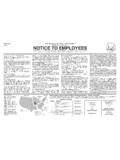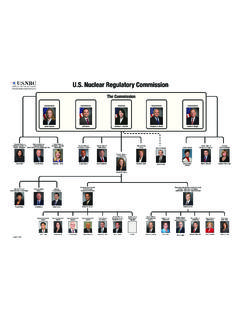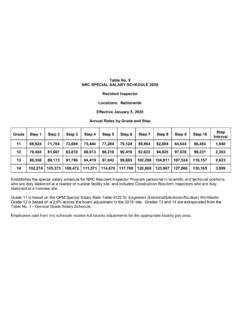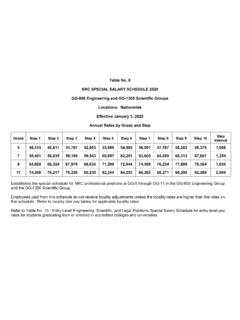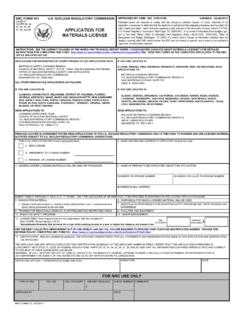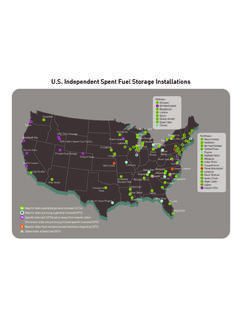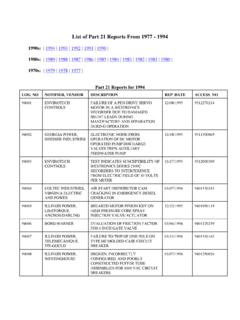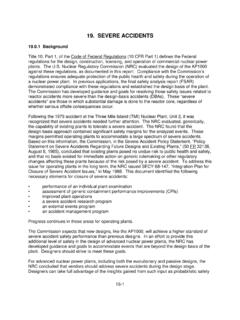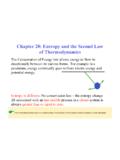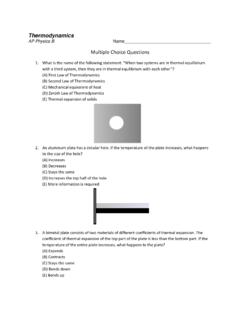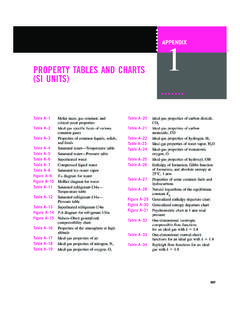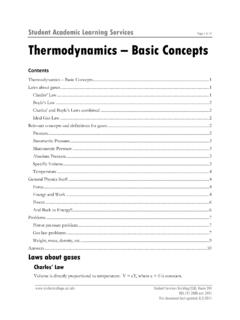Transcription of Chapter 2 Thermodynamics of Combustion
1 Chapter 2 Thermodynamics of Properties of MixturesThe thermal properties of a pure substance are described by quantities includinginternal energy,u, enthalpy,h, specific heat,cp, etc. Combustion systems consist ofmany different gases, so the thermodynamic properties of a mixture result from acombination of the properties of all of the individual gas species. The ideal gas lawis assumed for gaseous mixtures, allowing the ideal gas relations to be applied toeach gas component. Starting with a mixture ofKdifferent gases, the total mass,m,of the system ism XKi 1mi;( )wheremiis the mass of speciesi. The total number of moles in the system,N,isN XKi 1Ni;( )whereNiis the number of moles of speciesiin the system.
2 Mass fraction,yi,andmole fraction,xi,describe the relative amount of a given species. Their definitionsare given byyi mimandxi NiN;( )wherei 1,2,..,K. By definition,XKi 1yi 1 andXKi 1xi 1:S. McAllister et al.,Fundamentals of Combustion Processes,Mechanical Engineering Series, DOI ,#Springer Science+Business Media, LLC 201115 WithMidenoting the molecular mass of speciesi, the average molecular mass,M,of the mixture is determined byM mN PiNiMiN XixiMi:( )From Dalton s law of additive pressures and Amagat s law of additive volumesalong with the ideal gas law, the mole fraction of a species in a mixture can be foundfrom the partial pressure of that species asPiP NiN ViV xi.
3 ( )wherePiis the partial pressure of speciesi,Pis the total pressure of the gaseousmixture,Vithe partial volume of speciesi,andVis the total volume of the average intrinsic properties of a mixture can be classified using either a molarbase or a mass base. For instance, the internal energy per unit mass of a mixture,u,is determined by summing the internal energy per unit mass for each speciesweighted by the mass fraction of the Um Pimiuim Xiyiui;( )whereUis the total internal energy of the mixture anduiis the internal energy permass of , enthalpy per unit mass of mixture ish Xiyihiand specific heat at constant pressure per unit mass of mixture iscp Xiyicp;i:A molar base property, often denoted with a^over bar, is determined by the sumof the species property per mole for each species weighted by the species molefraction, such as internal energy per mole of mixture^u Xixi^ui.
4 Enthalpy per mole of mixture^h Xixi^hi;162 Thermodynamics of Combustionand entropy per mole of mixture^s Xixi^si:Assuming constant specific heats during a thermodynamic process, changes of energy,enthalpy, and entropy of an individual species per unit mass are described as follows:Dui cv;i T2 T1 ( )Dhi cp;i T2 T1 ( )Dsi cp;ilnT2T1 RilnPi;2Pi;1( )Pi,1andPi,2denote the partial pressures of speciesiat state 1 and state 2, the gas constant for speciesi(Ri ^Ru=Mi universal gas constant/molecularmass of speciesi). The overall change of entropy for a Combustion system isDS XimiDsi:A summary of the thermodynamic properties of mixtures is provided at the endof the Combustion StoichiometryFor a given Combustion device, say a piston engine, how much fuel and air shouldbe injected in order to completely burn both?
5 This question can be answered bybalancing the Combustion reaction equation for a particular fuel. A stoichiometricmixture contains the exact amount of fuel and oxidizer such that after Combustion iscompleted, all the fuel and oxidizer are consumed to form products. This idealmixture approximately yields the maximum flame temperature, as all the energyreleased from Combustion is used to heat the products. For example, the followingreaction equation can be written for balancing methane-air combustionCH4 ?O2 7921N2 !?CO2 ?H2O ?N2;( )where air consisting of 21% O2and 79% N2is coefficients associatedwith each species in the above equation are unknown.
6 By balancing the Combustion Stoichiometry17abundance on both the reactant and product sides, one can find the coefficientfor each species. For instance, let s determine the coefficient for CO2: on the reactantside, we have 1 mol of C atoms; hence the product side should also have 1 mol ofC atoms. The coefficient of CO2is therefore unity. Using this procedure we candetermine all the coefficients. These coefficients are called the reaction stoichiometriccoefficients. For stoichiometric methane Combustion with air, the balanced reactionequation reads:CH4 2 O2 3:76N2 !1CO2 2H2O 7:52N2:( )Note that on the reactant side there are 2 (1 + ) or mol of air andits molecular mass is kg/kmol.
7 In this text, the reactions are balanced using1 mol of fuel. This is done here to simplify the calculations of the heat of reactionand flame temperature later in the Chapter . Combustion stoichiometry for a generalhydrocarbon fuel,CaHbOg, with air can be expressed asCaHbOg a b4 g2 O2 3:76N2 !aCO2 b2H2O 3:76a b4 g2 N2:( )The amount of air required for combusting a stoichiometric mixture is calledstoichiometricortheoreticalair. The above formula is for a single-component fueland cannot be applied to a fuel consisting of multiple components. There are twotypical approaches for systems with multiple fuels. Examples are given here for afuel mixture containing 95% methane and 5% hydrogen.
8 The first method developsthe stoichiometry of Combustion using the general principle of atomic balance,making sure that the total number of each type of atom (C, H, N, O) is the same inthe products and the :95CH4 0:05H2 1:925 O2 3:76N2 !0:95CO2 1:95H2O 7:238N2:The other method of balancing a fuel mixture is to first develop stoichiometryrelations for CH4and H2individually:CH4 2 O2 3:76N2 !CO2 2H2O 2 3:76N2H2 0:5 O2 3:76N2 !H2O 0:5 3:76N2 Then, multiply the individual stoichiometry equations by the mole fractions of thefuel components and add them:182 Thermodynamics of Combustion0:95 CH4 2 O2 3:76N2 !CO2 2H2O 2 3:76N2fg0:05 H2 0:5 O2 3:76N2 !
9 H2O 0:5 3:76N2fg)0:95CH4 0:05H2 1:925 O2 3:76N2 !0:95CO2 1:95H2O 7 Methods of Quantifying Fuel and Air Contentof Combustible MixturesIn practice, fuels are often combusted with an amount of air different from thestoichiometric ratio. If less air than the stoichiometric amount is used, the mixture isdescribed as fuel rich. If excess air is used, the mixture is described as fuel lean. Forthis reason, it is convenient to quantify the combustible mixture using one of thefollowing commonly used methods:Fuel-Air Ratio (FAR): The fuel-air ratio,f,is given byf mfma;( )wheremfandmaare the respective masses of the fuel and the air. For a stoichio-metric mixture, Eq.
10 Becomesfs mfma stoichiometric Mf a b4 g2 4:76 Mair;( )whereMfandMair(~ kg/kmol) are the average masses per mole of fuel and air,respectively. The range offis bounded by zero and1. Most hydrocarbon fuels havea stoichiometric fuel-air ratio,fs, in the range of The air-fuel ratio (AFR) isalso used to describe a combustible mixture and is simply the reciprocal of FAR, asAFR 1/f. For instance, the stoichiometric AFR of gasoline is about For mosthydrocarbon fuels, 14 20 kg of air is needed for complete Combustion of 1 kg of Ratio: Normalizing the actual fuel-air ratio by the stoichiometric fuel-air ratio gives the equivalence ratio, ffs masma NasNa NO2sNO2;a( )The subscriptsindicates a value at the stoichiometric <1isaleanmixture,f 1isastoichiometricmixture, andf>1isarichmixture.
